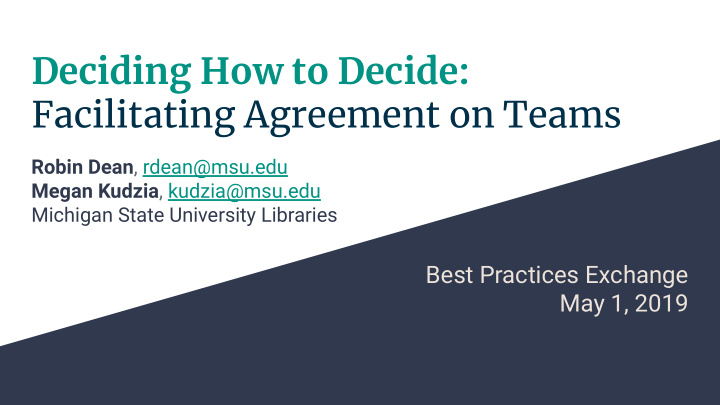



Deciding How to Decide: Facilitating Agreement on Teams Robin Dean , rdean@msu.edu Megan Kudzia , kudzia@msu.edu Michigan State University Libraries Best Practices Exchange May 1, 2019
Overview 1. Is it a team? 2. What can you decide? 3. How do you decide? This presentation also includes agile methods and kittens!
Is it a team? A set group of people Not a team who work together to No set group membership ● accomplish a common ● No common purpose ● Not collectively responsible goal: for getting anything done It's a team!
Deciding how to Things to discover early (if you can): decide is part of Is one person authorized to make decisions for the entire team? team formation How much agreement is your team comfortable with? Importance of decisions ● ● Urgency and timeline ● Ability to work iteratively
What can your team decide? Advisory Teams ● Give input to a (usually external) decision maker ● Have to decide what to recommend Example: search committees ● Empowered Teams ● Have authority and responsibility to make decisions within the team ● Example: agile development teams
Team Talk: Physical space design decisions: Advisory Role ● Team leader outlines the decision to be made Team leader provides options and ● Digital Scholarship a timeframe Lab Planning Team ● Other team members give feedback by the deadline Final decision sometimes made by ● team leader, sometimes consensus
Modes of decision 1. Delegate making on teams ○ One person decides ○ A subgroup decides 2. Vote ○ Majority rules ○ Fist-to-five 3. Reach consensus ○ Lazy consensus ○ Consensus
Delegate One person decides Could be a supervisor, chair, product owner, or other person of authority ● The decider should know when to get input from the team ● A subgroup decides Working groups or subcommittees formed within a larger team ● The subgroup should report back to the larger team ●
Team Talk: Reviewing website changes Delegate ● One team member makes the change according to a shared understanding of the task Digital Repository ( acceptance criteria ) Team ● Another team member reviews the change according to shared team standards ( definition of done ) ● The change can go live without the whole team looking at it
When you've already made the big decisions, it's easier to delegate small decisions. Image by Chiemsee2016 from Pixabay
Vote Majority vote Use for smaller, less critical, or less controversial decisions ● Fist-to-five vote ● Use when there is a greater range of opinions and more need for nuance Discussion can (and should!) happen before, during, and after votes.
Fist-to-Five voting 0 There's too many problems for (Fist) this to work! (veto option) 1 This idea has major problems. 2 This idea has minor problems. 3 This idea is fine. 4 This idea is good. 5 This idea is great! Hand Counting Fingers illustration from Pixabay
Team Talk: Tried fist-to-five voting, but ● couldn't agree on whether to include a veto option. To veto Adapt voting methods as ● or not to veto? necessary for your own team dynamics!
Use voting to move from discussions to decisions. Image by rihaij from Pixabay
Reach Consensus Lazy Consensus (No one objects) ● A way to delegate decisions, while giving others the time and opportunity to comment or disagree. If someone does object, switch to using a decision-making model that creates ● more buy-in. Consensus (Everyone agrees) Everyone either agrees with the decision, or agrees not to block the decision ● going forward.
Team Talk: After everyone has worked on the draft of a report: Lazy Consensus "Hey team, here's the final draft of the report. I'm going to send it out in 3 Finalizing a report days unless I hear otherwise . If you have any additional comments or changes, add them to the shared document before Thursday."
Consensus takes time, but it helps make decisions that stick. Image by Gisela Merkuur from Pixabay
Where can it go Not discussing how you're going ● to decide and who can decide. wrong? ○ You may need to do this for each decision for a while! ● Not knowing how much buy-in you need. ● Can't stick with decisions long enough to move forward.
Ask questions What helps? What can we decide? ● ● Do we need consensus? ● Can we vote to get a sense of Hint: what we're all thinking? Communication! Get buy-in to make the decision stick ● Start with the "minimum viable" decision-making method and escalate if needed. If you don't have deadlines, make some!
Sources and Further Reading ● Bethany Nowviskie, Lazy Consensus Roman Pichler, Use decision rules to make better product decisions ● ● Mike Cohn’s blog on Scrum and Agile techniques, especially Four Quick Ways to Gain or Assess Team Consensus ● Jake Calabrese, Agile for All, Learning with Fist of Five Voting Lucid Meetings, What is Fist to Five? ● ● Jeff Sutherland and Ken Schwaber, The Scrum Guide ● Patrick Lencioni, The five dysfunctions of a team: a leadership fable ● Brené Brown, Dare to lead: brave work, tough conversations, whole hearts
Deciding How to Decide: Facilitating Agreement on Teams Robin Dean , rdean@msu.edu Megan Kudzia , kudzia@msu.edu Michigan State University Libraries Best Practices Exchange May 1, 2019
Recommend
More recommend